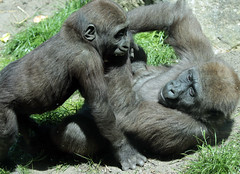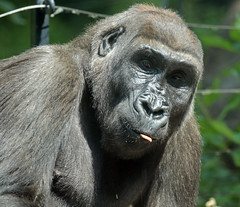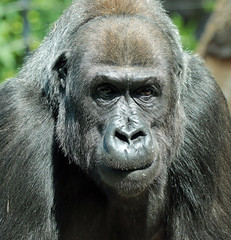Fotografias da África e das Antilhas
Descubram cada dias das Fotografias dos diferentes países da África e as Antilhas
Todas as imagens provêm do serviço de divisão de fotografia flickr
Utilizem a ementa de esquerda para escolher um país.
Zebra texture
AVINTES (Portugal): Zoo Santo Inácio.
78513424
KABO, CENTRAL AFRICAN REPUBLIC - DECEMBER 17: A boy looks out from a line formed for measles vaccination shots after 8 cases were reported in the area at a hospital December 17, 2007 in Kabo in the northern Central African Republic. Central African Republic (CAR) is one of the world?s poorest and most neglected countries with an average life expectancy of 39 years. Decades of fighting various rebel factions in the north of the country have resulted in hundreds of deaths and over 200,000 internally displaced people. Outside of the capital Bangui there is no electricity or paved roads and banditry is extensive. (Photo by Spencer Platt/Getty Images)
Giraffe silhouette
Sunset at Etosha National Park, Namibia.
All rights reserved. If you would like a full resolution version and whitout watermark, do not hesitate to contact me.
Feel free to comment, share and like my image and follow my page.
Sine-Ngayene stone circles panorama
Senegambian stone circles: The Senegambian stone circles / megaliths lie in central Senegal and in The Gambia north of Janjanbureh.
With an approximate area of 30,000 km˛, they are sometimes divided into the Wassu (Gambian) and Sine-Saloum (Senegalese) circles, but this is purely a national division. According to UNESCO, the Senegambian stone circles are "the largest concentration of stone circles seen anywhere in the world." These sites, Wassu, and Kerbatch in Gambia, and Wanar and Sine Ngayene in Senegal, represent an extraordinary concentration of more than 1,000 stone circles and related tumuli spread over a territory of 100 km wide and 350 km in length, along the River Gambia.
Researchers are not certain when these monuments were built, but the generally accepted range is between the third century B.C. and the sixteenth century AD. Archaeologists have also found pottery sherds, human burials, and some grave goods and metals around the megalithic circles.
Among these four main areas, there are approximately 29,000 stones, 17,000 monuments, and 2,000 individual sites. The monuments consist of what were originally upright blocks or pillars (some have collapsed), made of mostly laterite with smooth surfaces. The monoliths are found in circles, double circles, isolated or standing apart from circles (usually to the east) in rows or individually. These stones that are found standing apart outside the circles are called frontal stones. When there are frontal stones in two parallel, connected rows, they are called lyre-stones.
The construction of the stone monuments shows evidence of a prosperous and organized society based on the amount of labor required to build such structures. The stones were extracted from laterite quarries using iron tools, although few of these quarries have been identified as directly linked to particular sites. After extracting the stone, identical pillars were made, either cylindrical or polygonal, with averages at two meters high and seven tons.] The builders of these megaliths are unknown. Possible candidates are the ancestors of the Jola / Diola people, the Wolof or the Serer people.
Sine Ngayene is the largest of the four areas, and home of 52 stone circles, one double circle, and 1102 carved stones. It is generally accepted that the single burials found here predate the multiple burials that are associated with the construction of the stone circles. The site of Sine Ngayene is located just Northwest of Sine, Senegal, at the coordinates of 15°32′W, 13°41′N.
In 2002, an expedition was launched in the Petit-Bao-Bolong drainage tributary; it was called Sine-Ngayene Archaeological Project (SNAP). The team found iron smelting sites and quarries located close to the monument sites. They also found evidence of hundreds of homes nearby, dating around the time of the monuments, clustered in groups of 2–5 with remnants of house floors and pottery shards. This evidence suggests the existence of small, linked yet independent communities. Researchers also suggest the possibility that these megalithic cemeteries could have been a focal spot of the cultural landscape and served the purpose of bringing people together.
The site of Sine Ngayene has a Y-shaped central axis with a double circle (called Diallombere) located at the center of the three branches. Originally this site was surrounded by hundreds of tumuli (burial mounds) that leveled over time through erosion. Evidence suggests that the burials occurred first with the stones being erected later, exclusively for the burials. Often frontal stones were erected on the East side of the stone circles. Archaeologists at Sine Ngayene have constructed a timeline with four distinct, successive cycles. These cycles are based on materials buried in successive layers and the monument construction chronology of the double circle at the center of the site. The approximate date range assigned to this timeline ranges from 700 A.D. to 1350 A.D
Source: wikipedia 2020
western lowlandgorilla Yanga and damsi artis BB2A1304
j.a.kok posted a photo:
western lowlandgorilla Yanga and damsi artis BB2A1237
j.a.kok posted a photo:
western lowlandgorilla Yanga and damsi artis BB2A1304
j.a.kok posted a photo:
western lowlandgorilla Shae Yanga artis BB2A1316
j.a.kok posted a photo:
western lowlandgorilla Yanga artis BB2A1124
j.a.kok posted a photo:
western lowlandgorilla Douli artis BB2A1031
j.a.kok posted a photo:
western lowlandgorilla Shae Yanga artis BB2A1315
j.a.kok posted a photo:
western lowlandgorilla Binti artis BB2A1055
j.a.kok posted a photo:
western lowlandgorilla Akili artis BB2A1178
j.a.kok posted a photo:
western lowlandgorilla Yanga and damsi artis BB2A1289
j.a.kok posted a photo:
KAN Festival 2020
kanfestival1 posted a photo:
KAN Festival 2020
kanfestival1 posted a photo:
KAN Festival 2020
kanfestival1 posted a photo:
IITA's Agriserve and Cropnuts Kenya partner to launch agricultural joint venture
bulletin.iita.org/index.php/2019/12/16/agriserve-partnere.... Photo by IITA.
KAN Festival 2020
kanfestival1 posted a photo:
KAN Festival 2020
kanfestival1 posted a photo:
Imagens automaticamente encarregadas desde flickr com para tags : (afrique,africa,antilles)















